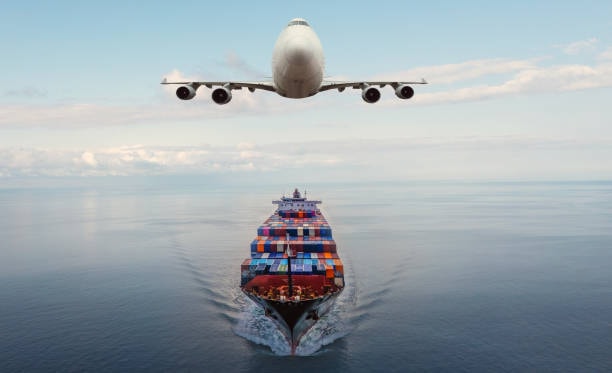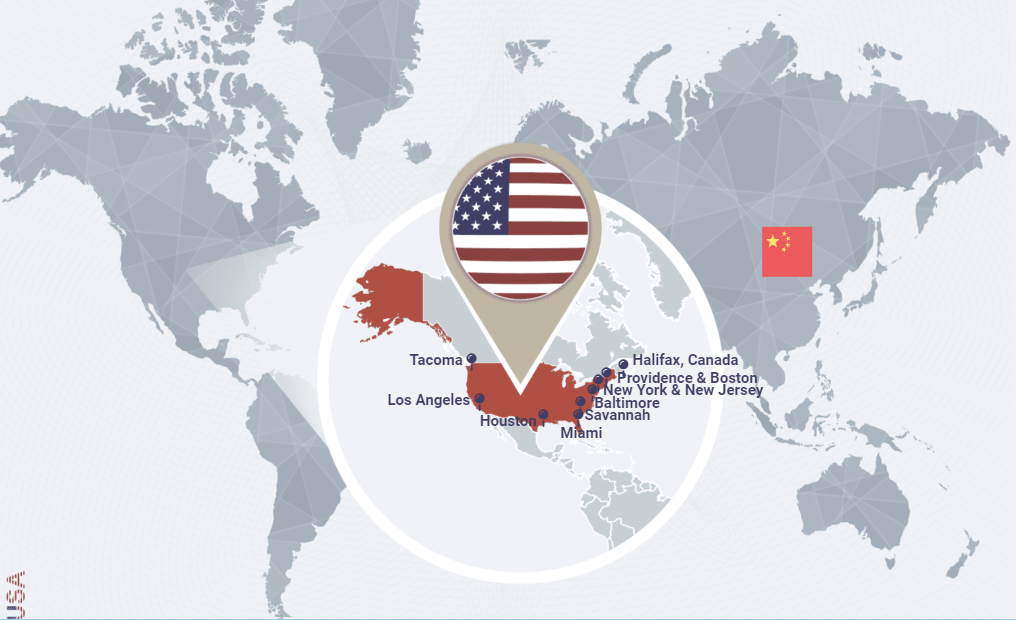Shipping from China to USA: 2025 Complete Guide to Sea & Air Freight, Customs, Transit Times and Costs
Plan faster arrivals and lower landed costs from Shenzhen, Shanghai, Ningbo, Qingdao, Guangzhou & more to Los Angeles/Long Beach, New York/New Jersey, Savannah, Houston, Oakland, Seattle/Tacoma, Miami, and Chicago air hubs.
1) Executive Overview
China to USA shipping underpins thousands of supply chains—from electronics and apparel to machinery and furniture. The best results come from aligning mode (sea vs. air), contracting (FCL/LCL vs. standard/express air), Incoterms (EXW/FOB/CIF/DAP/DDP), and customs readiness (ISF/AMS, entry, bond, duties) with SKU margins and service levels. This guide distills field-tested practices to improve reliability and reduce total landed cost without compromising speed.
- Sea freight (FCL/LCL): lowest unit cost; typical door-to-door 30–45 days depending on lane and season.
- Air freight: fastest; typical door-to-door 5–10 days (airport-to-airport 3–7 days).
- DDP door-to-door: duties/taxes handled by the shipper/forwarder for a predictable, low-friction experience.
- Compliance first: clean documents, correct HS codes, and timely ISF 10+2 avoid expensive delays.
2) Origins & Destinations: Ports and Airports That Matter
2.1 Top China Load Ports
- South China: Shenzhen (Yantian/Shekou), Guangzhou (Nansha), Xiamen.
- East China: Ningbo-Zhoushan, Shanghai (Yangshan/Waigaoqiao).
- North China: Qingdao, Tianjin (Xingang), Dalian.
- Hong Kong: gateway with strong air uplift and feeder networks.
2.2 USA Gateways
- West Coast: Los Angeles/Long Beach (LAX/LGB), Oakland, Seattle/Tacoma.
- Gulf: Houston, New Orleans (specialized & project cargo options).
- East Coast: New York/New Jersey, Savannah, Charleston, Norfolk, Miami.
- Air hubs: LAX, ORD (Chicago), JFK/EWR (NYC), DFW, ATL, MIA, SFO, SEA.
3) Shipping Modes & When to Use Them
3.1 Ocean Freight: FCL vs. LCL
FCL (Full Container Load) gives you the entire container (20GP, 40GP, 40HQ, 45HQ). It’s best when your cargo approaches ~18–20 m³ or higher, or when you need security and fewer handoffs. LCL (Less than Container Load) consolidates multiple shippers—great for 1–12 m³ shipments but adds CFS (consolidation/deconsolidation) steps and a few days of dwell at origin/destination.
- Pros (FCL): faster terminal handling, less risk of co-loader delays, potentially lower total cost per unit at scale.
- Pros (LCL): pay-as-you-go by volume; perfect for market tests and initial replenishment.
- Reefer & special: reefer, open-top, flat-rack available for temperature control and oversize cargo.
3.2 Air Freight: Standard, Express, and Charter
Air is ideal for high-value and time-sensitive goods or when stock-out costs exceed freight premiums. Chinese uplift through PVG/SZX/CAN/HKG/PEK reaches US hubs with both direct and one-stop connections.
- Standard air: best balance of speed and cost; chargeable weight = max(actual, volumetric L×W×H/6000 in cm).
- Express courier: DHL/FedEx/UPS, time-definite, dimensional divisor often 5000—great for samples/small parcels.
- Charter: for urgent, outsized, or lane-disrupted scenarios.
3.3 Door-to-Door: DAP vs. DDP
- DAP (Delivered At Place): shipper pays freight to named place; buyer handles duties/taxes on arrival.
- DDP (Delivered Duty Paid): shipper/forwarder pays duties/taxes and delivers to door—predictable landed costs, less admin for buyers.
4) Incoterms & Contracting: Get the Split Right
Choose Incoterms to match control, risk, and cost.
- EXW: buyer controls everything from seller’s door—only advisable if you can manage China pickup/export efficiently.
- FOB: widely preferred—seller clears export and loads onboard; buyer controls main leg and destination.
- CIF/CFR: seller covers ocean freight (and insurance for CIF) to the US port; buyer handles import and last mile.
- DAP/DDP: end-to-end simplicity; DDP includes duties/taxes.
5) US Customs & Compliance: Step-by-Step
5.1 ISF 10+2 (Importer Security Filing)
For ocean shipments, ISF must be filed before vessel loading at origin. Late or inaccurate ISF can trigger penalties and holds. A reliable forwarder/broker workflow keeps supplier and booking data aligned to avoid misses.
5.2 AMS Manifest & Arrival
Carriers file AMS; you’ll track carrier arrival notices and terminal availability. For LCL, monitor CFS availability; for FCL, arrange drayage appointments swiftly to use free time effectively.
5.3 Entry Filing & Importer of Record
- Importer of Record (IOR): responsible for entry filing and duties/taxes.
- Customs bond: single-entry for one shipment or continuous bond for frequent imports.
- Entry documents: commercial invoice, packing list, bill of lading/air waybill, and any partner-agency permits (FDA/EPA/USDA/FCC, etc.).
5.4 Duties, Taxes & Fees (High-Level)
- Customs duty: based on HTSUS classification and value for duty.
- Harbor Maintenance Fee (HMF): assessed on ocean imports (not air).
- Merchandise Processing Fee (MPF): percentage/min-max rules apply to formal entries (values and caps can change—confirm current figures with your broker).
- Additional measures: e.g., Section 301/antidumping/countervailing duties—verify current applicability before booking.
5.5 Partner Government Agencies (PGAs)
Depending on the product, agencies like FDA (food/cosmetics/medical), EPA (chemicals), USDA/APHIS (plants/wood), FCC (communications) may require prior notices, registrations, or certificates.
5.6 Marking & Recordkeeping
- Country of origin marking required (“Made in China”); ensure labels are durable and legible.
- Five-year recordkeeping on customs entries is common best practice.
6) Transit Times: What’s Realistic by Lane
Plan door-to-door windows that incorporate origin handling, main leg, arrival/clearance, and last mile.
| Lane | Ocean Port-to-Port | Door-to-Door (Ocean) | Air A2A | Door-to-Door (Air) |
|---|---|---|---|---|
| Shenzhen → Los Angeles/Long Beach | 14–18 days | 28–38 days | 3–5 days | 5–9 days |
| Shanghai → New York/New Jersey | 24–32 days (via canals) | 35–45 days | 4–6 days | 6–10 days |
| Ningbo → Houston | 22–30 days | 32–42 days | 4–6 days to IAH | 6–10 days |
| Qingdao → Savannah | 26–34 days | 36–46 days | 4–7 days (via ATL) | 6–10 days |
| Guangzhou → Seattle/Tacoma | 15–20 days | 28–40 days | 3–5 days | 5–9 days |
Tip: LCL adds 2–6 days for CFS steps; rail/truck legs to inland DCs add 1–7 days depending on appointment rules and season.
7) Cost Benchmarks & What Moves the Price
| Mode | Unit | Indicative Rate | Best Use |
|---|---|---|---|
| FCL 20’ | per cntr | USD 2,500–3,800 | Bulk pallets, furniture, heavy SKUs |
| FCL 40’ | per cntr | USD 3,000–5,500 | High-volume wholesale replenishment |
| LCL | per m³ | USD 150–250 | 1–12 m³ mixed cargo |
| Air freight | per kg | USD 6.5–15.5 | Urgent or high-value goods |
| Express | per kg | USD 10–20 | Samples, small parcels |
| DDP (door) | per kg/CBM | USD 6–15 / 200–300 | All-in predictability |
7.1 Key Drivers
- Seasonality & capacity: peak months and blank sailings affect sea; holidays and tariff shifts affect air.
- Volume & density: air/express bill by chargeable weight; optimize cube utilization.
- Origin/destination pairing: West Coast vs. East/Gulf balances sailing times, dray, and rail costs.
- Value-added: appointments, storage, chassis, to-door surcharges can add up—budget them.
8) Packaging, Labeling & Insurance
- Use export-grade cartons, edge protectors, moisture barriers; add desiccants for winter Pacific crossings.
- ISPM-15 pallets; stack to avoid crushing; keep CG (center of gravity) low in FCL.
- Carton labels: SKU, PO, carton #, dimensions, “Made in China”, handling marks.
- Cargo insurance: all-risk cover recommended; typical premium ~0.3–0.6% of insured value.
9) Amazon FBA & Retail DC Delivery
- Follow FBA carton/pallet label rules; book appointments where required.
- Launches: split air + ocean; replenishment: consolidate to 40HQ for lower unit cost.
- For DDP to FBA, verify consignee name formatting to avoid dock rejections.
10) Practical Playbooks
10.1 Startups & Trial Batches
- LCL or express for samples and micro-launches; switch to FCL as volume stabilizes.
- FOB + continuous bond if you ship monthly; otherwise single-entry bond may suffice.
10.2 Scaling D2C/E-commerce
- Hybrid cadence: air for new SKUs, FCL for base demand.
- DDP to simplify taxes/duties; publish delivery SLAs with realistic buffers.
10.3 B2B Wholesale/Big Box
- 40HQ FCL with stable sailing windows; rail to inland DCs where cost-effective.
- Track free time to avoid demurrage/detention; book dray in advance.
11) Compliance Checklist (Copy & Use)
- Confirm HS codes and any partner-agency requirements (FDA/EPA/USDA/FCC etc.).
- Book space early in peak seasons; align CY cut and VGM deadlines.
- Assemble documents: commercial invoice, packing list, B/L or AWB, certificates if needed.
- ISF filed before loading (ocean); verify data sources (supplier, booking, HTS).
- Arrange customs bond (single or continuous); pre-clear where possible.
- Plan inland dray/rail/truck; monitor free time and chassis availability.
- Apply origin marking and label rules; photograph packaging/palletizing as evidence.
- Bind cargo insurance; set claims workflow and contacts.
12) Quick Glossary
- FCL/LCL: full/partial container usage.
- ISF 10+2: importer security filing for ocean before loading.
- AMS: automated manifest system (carrier filing).
- MPF/HMF: US entry fees; confirm current rates with your broker.
- IO R: Importer of Record—the legal party responsible for the entry.
13) Frequently Asked Questions (FAQ)
How long does it take to ship from China to the USA?
Ocean door-to-door typically 30–45 days depending on lane and season; air door-to-door 5–10 days.
What’s the cheapest way to ship?
Ocean FCL offers the lowest unit cost at scale; LCL is best for 1–12 m³ trials. Air is for urgent/high-value SKUs.
Do I need a US customs bond?
Yes for formal entries; use single-entry for ad hoc shipments, continuous bond for frequent imports.
What documents are required?
Commercial invoice, packing list, bill of lading/air waybill, and any partner-agency permits; accurate HS codes are critical.
Is DDP worth it?
For first-time importers or non-resident buyers, DDP simplifies duties/taxes and provides predictable landed costs.
How do I reduce delays?
Timely ISF, clean docs, pre-clear entries, and early dray/appointment bookings; add buffers in peak months.
Can you deliver to Amazon FBA?
Yes—label compliance, appointments, and DDP/DAP options are available.
Ready to Move Your Next Shipment?
From RFQs to continuous replenishment programs, our China–USA teams plan, execute, and optimize your lane—end to end.



